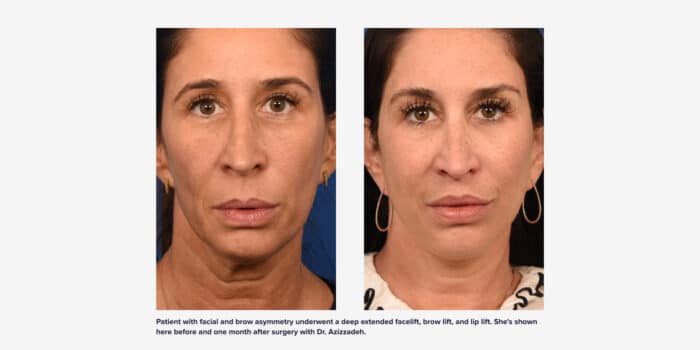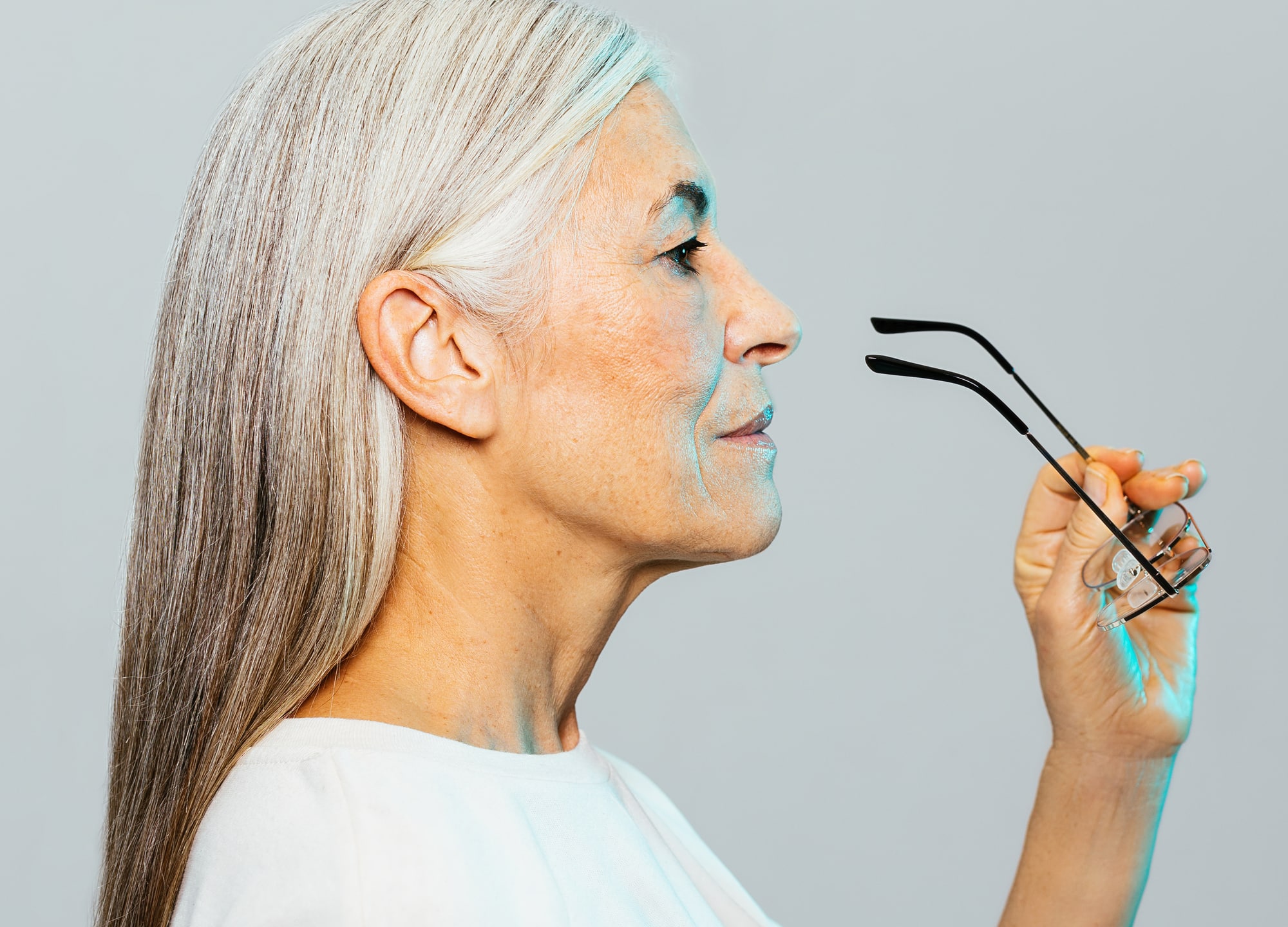In aesthetics, there are plenty of times when we fail to see the forest for the trees—when a tiny detail (be it a wrinkle or a bulge) blinds us to the bigger, grander picture. (The pandemic Zoom boom was basically born of this phenomenon.) Interestingly, however, when we’re reviewing facelift before and after photos, the opposite is often true: The proverbial forest tends to steal our focus. We’re so captivated by the sweeping change—that jawline transformation—that we miss the finer aspects of the outcome, which are equally deserving of scrutiny and appreciation.
In truth, it’s the subtleties of a facelift that can make or break a result. Ahead, top facial plastic surgeons share the eight things they always look for in facelift B&As.
1. Consistency
By now, you likely know to look for consistent lighting, facial expressions, and focal length (the subject’s distance from the camera) when analyzing plastic surgery B&As. But with facelift photos, in particular, you also want to make sure the patient’s head is in a similarly neutral position in both pics.
“Consistent positioning is critical for facelift and neck lift B&As to be valid,” says Dr. Justin C. Cohen, a board-certified facial plastic surgeon in McLean, Virginia. “Many before photos show the patient’s neck slightly flexed downward, with the chin a bit tucked, whereas the afters show the neck extended, which artificially tightens the jawline and exaggerates what was truly achieved by the surgery.” It can be tricky to gauge the sameness of positioning when looking at the chin or neck, since presumably, both have been dramatically altered in surgery. So instead, Dr. Cohen recommends checking for consistency in the nose or forehead position.
2. Fine, carefully hidden scars
Facelift incisions are generally hidden in the creases of the ears (front and back) as well as in the hairline by the temples and behind the ears. So step one to judging facelift scars, says Dr. Cohen, is “to look for B&As where the hair is pulled or tucked back, to ensure the surgeon has nothing to hide.” This may seem painfully obvious, but we’ve come across countless facelift afters with curtains of hair obscuring the ears.
Next, when perusing scars, consider the timing of the photo. “It’s important to see how scars look at one week and one month post-op, because people are starting to go out at that point and you want to make sure they’re presentable, but facelift scars take a year to fully develop,” explains Dr. Babak Azizzadeh, a board-certified facial plastic surgeon in Beverly Hills, California. That said, he adds, typically at one week, the scars will look red. At one month, they’ll appear pink. And by three months, they should be barely visible in front of the ear, but “behind the ear, there may still be some irregularity.” Any abnormalities should flatten and fade by one year.
Ultimately, “the scar may be lighter [than the surrounding skin], but the key is that it’s well camouflaged in the grooves around the ears and that it’s very fine—like, as fine as a single hair,” says Dr. Elizabeth Chance, a board-certified facial plastic surgeon in Charlottesville, Virginia.
Wide scars tend to signal poor technique and “may indicate that the skin was pulled too tight and that the incisions were closed under tension—this causes the scars to stretch out as the face settles during healing,” Dr. Cohen says. Ideally, the deep, supportive layers of the face bear the strain of the lift while the skin is simply redraped, trimmed, and closed without being pulled taut. Meticulous suturing matters too, Dr. Cohen adds. “Over half of my surgical time is spent closing the incisions—and this is time well spent.”
3. Natural-looking ears
Tugging the skin and closing facelift incisions under tension can also upset the natural shape and position of the ears. “Over time, as the face relaxes, it can pull on the loose structures of the ears,” says Dr. Cohen, stretching the earlobes (giving pixie vibes) or distorting the tragus (the tab of cartilage atop the ear canal).
According to Dr. Azizzadeh, an overly plump tragus is a major facelift tell. “The natural skin on the tragus is super-thin, but when we do a facelift, we’re bringing thicker skin [from the face] over it,” he explains. To cover their tracks, good surgeons will take time to de-fat, or thin out, the skin intended for the tragus and to re-create its natural contours.
There’s some debate among doctors as to whether the earlobes should maintain their “before” form—be it attached or detached—following a facelift. While some surgeons insist on keeping them as is, others see the earlobes as an opportunity to improve the overall result of a facelift. “When you create this beautifully sculpted jawline and gorgeous neck but then there’s these massive earlobes—that really bothers me,” says Dr. Chance. Which is why she routinely has “the earlobe discussion” with facelift patients, asking them if they’d like to tweak their lobes in any way during surgery. “You don’t have to keep the earlobes exactly the same—that’s kind of an old-school mentality,” she says. What’s most important is that they look natural and suit the patient’s newly rejuvenated face and neck.
4. Lifted cheeks
“One of the major reasons patients see me for revision facelifts is that although they might be happy with their neck results, they feel their face still looks tired and that they no longer look like themselves,” says Dr. Cohen. This tends to happen when surgeons fail to lift the cheeks.
Dr. Chance tells us that cheek elevation is the number one thing she looks for in a modern facelift (particularly one claiming to be an extended deep plane facelift, which aims to release certain ligaments to achieve greater mobility in key areas, like the cheeks and jawline). When a surgeon returns fallen cheek fat back to its original position, not only does this make the midface look fuller, but it naturally softens the nasolabial folds and gives the lower eyelids—the shape of the orbit, as a whole—a more youthful look, she says.
5. Undisturbed sideburns
While you may not have given much thought to your sideburns before, if they were to one day relocate or disappear, you’d surely notice. “In both men and women, sideburns are an important landmark that must be preserved in order for the patient to look most natural,” says Dr. Cohen.
Yet sideburns can sometimes get lost in the pursuit of the perfect scar. “In order to avoid the risk of visible scarring, some surgeons choose to continue this incision behind the sideburn and straight up into the scalp,” Dr. Cohen explains. “But when the face is lifted, the sideburn becomes included as part of the lift—meaning it will be moved upward and back, creating a telltale sign that a facelift was performed.” Surgeons can prevent this by placing incisions below and in front of the sideburn, to keep its position consistent from before to after.
Disturbed sideburns are a more glaring fail on men, since the shift can place coarsely stubbled skin inside the ear. When operating on guys, Dr. Azizzadeh will sometimes adjust his technique to make minimal incisions, cutting under the chin to address the platysma muscle in the neck; tending to the SMAS (the fascia of the facial muscles) and removing excess skin through an incision behind the earlobe; restoring the cheeks with fat transfer; and even improving the jowls by suspending the buccal fat pad from inside the mouth. “This avoids all incisions in front of the ear so that the hairline and sideburns don’t move,” he says.
6. Symmetry and identity
Look for preexisting facial asymmetries in the before and see how they were corrected (or not) in the after. “Symmetry is a huge, underestimated issue in facelifting,” notes Dr. Azizzadeh. Most humans have some degree of facial asymmetry that they are either born with or have acquired through aging. “Sometimes there are variations in volume or laxity between the two sides of the face or slight differences in eye positioning,” he says—all of which should be pointed out and discussed prior to surgery.

While some patients and doctors like to fix asymmetries during a facelift, there’s no rule requiring they be righted. “In my opinion, it’s the subtle facial asymmetries that make up our unique facial appearance, and [I think] these should be preserved,” Dr. Cohen says. “When evaluating facelift B&As for symmetry, the key is to see if the patients still look like themselves.”
7. A crisp, continuous jawline and smooth neck
There’s more to a rejuvenated jawline and neck than meets the eye, experts say. Beyond crisp lines and sharp angles, there are quieter elements comprising these striking facelift features.
- Over time, the entire jawbone recedes and its overlying fat layer shrinks. “Check to see that these losses were addressed through fat grafting and/or a chin implant,” Dr. Azizzadeh says.
- There should be a smooth transition between the chin and the jawline itself, which can come from releasing the mandibular ligament to smooth the pre-jowl sulcus (or the dip between chin and jaw). “If you don’t release that ligament, you’ll still have that indentation even though there’s no longer a true jowl,” Dr. Chance notes.
- “I look for smooth contours without significant irregularities in the skin, minimal fullness beneath the jawline, a strong gonial angle at the back of the jawbone, and the absence of unnatural folds along the sides of the neck,” says Dr. Cohen. Those folds or vertical pleats may mean that the back edge of the platysma wasn’t adequately adjusted, adds Dr. Chance. “You want to see that the whole neck was rejuvenated,” she says.
- The neck should not be skeletonized, says Dr. Chance. Rather, it should possess “a gentle curve that shows someone really thought about how to tailor the fat and deeper structures in the neck.”
8. An unpulled appearance
Pay close attention to the corners of the mouth and the orientation of the wrinkles in after photos (particularly in the three-quarter view shots, which are often most revealing, notes Dr. Azizzadeh). A Joker smile, upswept lines, or a windtunnel appearance suggests that the skin was pulled taut or that the skin and/or deeper structures were hoisted in an inappropriate direction or vector. Pulling at the corners of the mouth, for instance, “may mean the face was repositioned more horizontally, which distorts the mouth, as opposed to vertically, which is the preferred method of correcting gravity-related changes,” notes Dr. Cohen.











